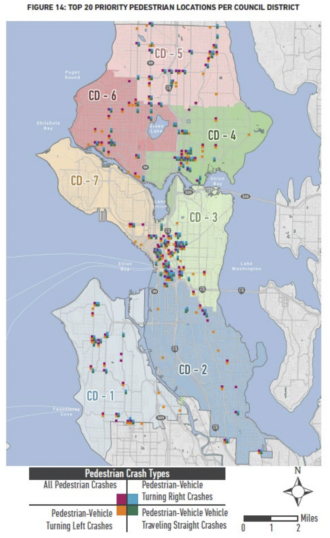
SDOT is set to present their “top to bottom review” of the Vision Zero program to the City Council Transportation Committee March 7, and safe streets advocates are pushing for more specifics and hard deadlines to “light a fire under our elected leaders to get Vision Zero back on track,” as Cascade Bicycle Club put it.
In our previous story about the first draft of the Vision Zero review, we noted that a lot of the recommendations were internal-facing things like reorganizing internal processes and the department hierarchy. This is not necessarily a criticism of the review since this was its stated goal, but it’s also hard for the public to understand the impact of these internal changes.
The review includes lots of important findings and great statements about what needs to happen, such as the recommendation that the department must “Be willing to reduce vehicle travel speeds and convenience to improve safety.” But the review was somewhat lacking in specifics and timelines for making those necessary changes. Cascade and Greenways noticed this, too.
“[T]he public needs to know that tangible actions are coming next,” Cascade wrote in their sample letter that people can send to Councilmembers. Use their handy online tool to send your own letter. “Otherwise, it’s just another plan that gets put on a shelf.” Specifically, they are calling for Council to place a timeline on SDOT to accomplish tasks from the review, including a revision of the Vision Zero Action Plan, expanding turn on red restrictions, programming leading pedestrian intervals (giving walk signals a head start), and requiring follow-up progress reporting on these changes.
Seattle Neighborhood Greenways already offered their Vision Zero ideas back in November, which includes a lot more specific interventions the city could take. Much of their suggestions might be more appropriate for the Vision Zero Action Plan, which is why accelerating delivery of that update is important. This departmental review document is not going to get Vision Zero back on track, but it could help SDOT more effectively deliver safety-focused actions that the Mayor and Council task them with.
This Vision Zero review was commissioned by Mayor Bruce Harrell. It is an opportunity for him to take on street safety on his own terms and make safety the centerpiece of his Seattle Transportation Plan and levy replacement package in 2024. The Mayor and SDOT are admitting here that what we’re doing is not working, and that’s a big deal. Safe streets advocates have been forced into an adversarial role in our city for a while, and this could be an opening to instead be in an encouraging role. My advice to advocates is to push for more of course, but don’t forget to cheer for this work as well. After a half decade of playing desperate defense to try to stop or at least reduce cuts to safe streets projects, this is a chance to build momentum for the next big step forward.
Seattle can reach Vision Zero by 2030. We know how to make our streets safer, and we know which places need those safety changes the most. The great thing about making physical safety changes to a street is that the benefits repeat annually. So each project builds on the others, and the number of danger spots gets smaller and smaller. Right now the scale of the problem feels overwhelming, but it is manageable with the right resources and political leadership. The people of Seattle are ready for a major increase in safety work. We will absolutely vote for a levy that puts safety first and directs big dollars to the effort. But it’s going to take a lot of advocacy to make all that happen, so get engaged and help out however you can.
Seattle Neighborhood Greenways released this video about their 2023 Vision Zero goals:
Here’s the sample letter from the Cascade action alert:
Thank you for requesting that the Council Transportation Committee is briefed on the Vision Zero Top to Bottom Review. Everyone agrees – Vision Zero is off track.
The big question is, where to go from here? I am glad that the department has undertaken this review to understand how it needs to improve internally and to confirm its commitment to prioritizing safety over speed in our transportation system. However, the public needs to know that tangible actions are coming next. Otherwise, it’s just another plan that gets put on a shelf.
People biking and walking can’t wait. Every day people are injured, or worse, simply traveling from A to B on Seattle streets.
In the March 7 Transportation Committee meeting, please urge SDOT to act swiftly and report back to the committee on the following items:
— Request a timeline of the plan to ban right turns on red and increase leading pedestrian intervals, including where these interventions will be located, and why the plan is only for downtown when the city’s own data shows this safety measure would be of benefit citywide.
— Request a timeline for the release of the Vision Zero Action Plan. Please demand aggressive action.
— How will the results of the department’s internal process improvements to “lead with safety” be demonstrable to the public?
— Request a progress report on the department’s internal process changes.Thank you for ensuring accountability to the city’s plans, so that everyone can get around safely in Seattle, regardless of how we choose to, or need to, travel.








Comments
One response to “Greenways and Cascade seek more specifics in plan to get Vision Zero back on track”
Love this post. A positive way to respond to the review by encouraging SDOT, the mayor, and the city council to continue to make street design changes and let them know we are behind them in making safety a priority.